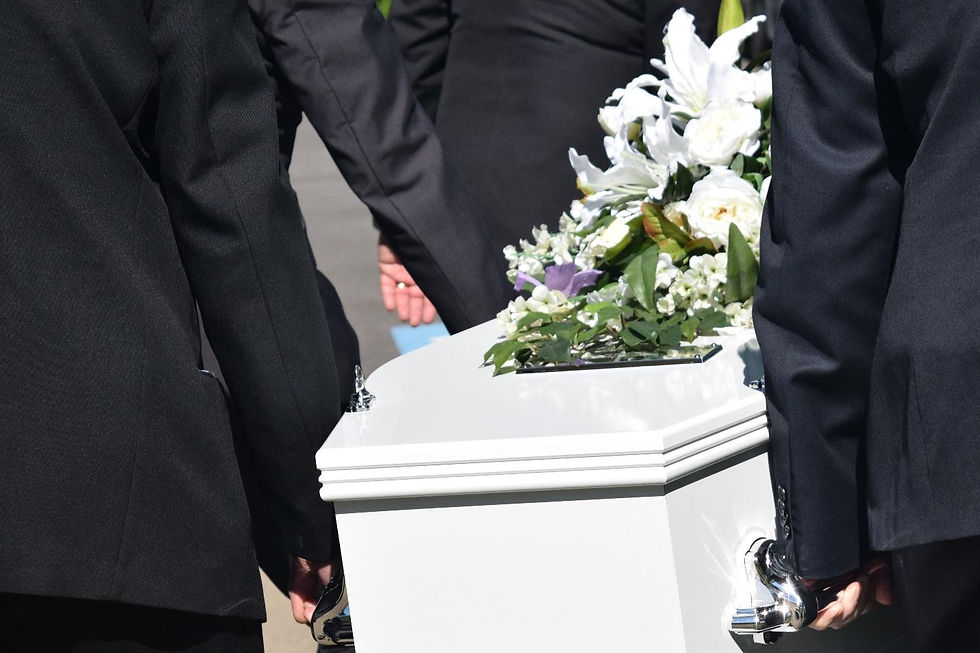The Funeral Process Explained: What to Do When a Loved One Passes Away
- LONITÉ

- Feb 21, 2022
- 16 min read
Updated: Sep 20, 2023

TABLE OF CONTENT

When it comes to discussing the funeral process, a lot of people don’t know what to do. Losing a loved one is sometimes unexpected and usually terrifying, but it’s all part of life’s complex design that we must inevitably prepare for.
A funeral is a ceremony connected with the final disposition of a corpse. The funeral process in the UK, USA, and Australia involves all preparations for a corpse, the funeral service, and final disposition.
The average time between death and the funeral is 2 to 5 days in Australia, 3 to 7 days USA, and 1 to 2 weeks in the UK. Most religions require the corpse to be buried as soon as possible if a traditional cemetery funeral ceremony is planned.
The First Steps to Take after the Death of a Loved One
Before we dive into the nitty-gritty of the funeral process and making funeral arrangements, you should know that there are a million things to take care of when a loved one dies, and below are the crucial things to strike off your funeral arrangement checklist:
Determine the Cause of Death

When a loved one dies unexpectedly, instead of making funeral arrangements immediately, first call the emergency services to request for an ambulance and the police. These will contact a Coroner to determine the cause of death before allowing the death to be registered. A funeral ceremony cannot be conducted until the Coroner’s inquest has been completed and a cause of death has been established.
If a person died abroad, register the death in the country in which he/she died to get a consulate death certificate and also register it in the country of birth before making funeral arrangements.
If your loved one dies at home, and the death was expected, call their General Practitioner (GP) or the National Health Service helpline. They are the first contact in the funeral process. If the cause of death is known, a doctor will issue a Medical Certificate of Cause of Death, allowing you to register the death before proceeding with the funeral process in UK, USA, or Australia.
If your loved one passes away in a hospital, there is hospital staff specialized in bereavement matters to explain the funeral procedures to you so you can effectively plan a funeral.
Obtain the Medical Certificate of Cause of Death
Acquiring a Medical Certificate of Cause of Death depends on where your loved one died and is issued only if the cause of death is known. This certificate is required in order to register the death of your loved one in their birth country — this must be done within 5 days in England or Wales and within 8 days in Scotland before you plan a funeral. Deaths in Australia must be registered within 7 days.
The certificate usually includes the following information about the deceased; Name, Age, Place of death, and Cause of Death. The difference between a Death certificate and a Medical Certificate of Cause of Death:
a. Medical Certificate of Cause of Death: Issued by a doctor after someone has died. It details the cause of death and is required to register the death before the funeral process begins.
b. Death Certificate: A statutory certificate issued by the registrar at the time that death is registered. This is an official notification that a death has occurred. Acquiring the death certificate is vital to commencing the funeral procedure.
Across the UK, each certified copy of a death certificate costs between £8.00 and £11.00, in the USA, prices range from $5.00 to $25.00 depending on the State and Australia charges $77.00 (this includes a standard certificate).
Registering the Death of a Loved One
The next step is registering the death of your loved one, it is vital in commencing the funeral process. To register a death in the UK, find the nearest registrar’s office or the nearest vital statistics office for those in the USA. Death is registered by the deceased’s next of kin or any close relative as they are probably the ones who’ll plan the funeral.
To register a death, you need the following documents; a Medical Certificate of Cause of Death signed by a doctor, a Birth Certificate, a Council Tax bill, a Driving License, a Passport, a Marriage/Civil Partnership Certificate if applicable, an NHS Medical Card, and Proof of address.
You also need to provide the registrar with; the name of the person who died, home address, date and place of birth, details of where and when the person died, occupation if applicable, the name, occupation, and date of birth of their spouse or civil partner if applicable and if they were receiving any benefits, including pensions or allowances from public funds.
After registering a death, you will receive a Green Certificate that allows you to bury or cremate your deceased loved one in the UK. This is called a Cremation Permit or a Disposition Permit in the USA and Australia and it is needed to begin funeral arrangements.
The UK has a “Tell Us Once” service that allows you to notify the death of your loved one to various government departments simultaneously. Some of the departments in this service include; HM Revenue and Customs (HMRC), Department for Work and Pensions (DWP), Passport Office, Driver and Vehicle Licensing Agency (DVLA), The local council, and Veterans UK). This service helps quicken the funeral process.
Arranging a Funeral Ceremony For A Departed Loved One

Now that you’ve obtained the necessary documents, it’s time to proceed with the funeral process. There are a number of things to remember when organizing a funeral ceremony which is why it is important to keep a funeral arrangements checklist.
A funeral arrangement checklist spells out all the things that need to be put in place for the funeral ceremony including the funeral arrangement cost and the funeral service price. Your funeral arrangement checklist should include:
A decision on whether to use a funeral director or arrange the funeral yourself. A funeral director helps you in deciding on the most fitting tribute for your deceased, honoring any final wishes and ensuring that the funeral has a personal touch. If you are arranging the funeral ceremony yourself, ask for assistance from your family and friends, especially in gathering family photos and the stories they'd like to share. This would ease the somehow tedious funeral process. Also, decide on the best location for the event together and on who will give the eulogy.
A decision on what type of funeral to have — traditional burial or cremation. The traditional burial funeral ceremony involves burying the body in a coffin in the ground and cremation on the other hand involves burning the corpse and converting it to ashes.
Coffin preference: It is not compulsory to buy a coffin when your loved one passes on, you can rent a coffin for only the viewing ceremony in the funeral process. These rental boxes are eco-friendly and have a removable interior thus the body never touches the casket; this interior is removed after the funeral service for burial and cremation. If you pick an eco-friendly burial, the coffin must be biodegradable from materials such as cardboard, bamboo, pine, or banana leaves. Sea burials also have very strict rules about the type of coffin you can use.
The kind of funeral service: The funeral service can be customized to include funeral music, funeral hymns, prayers, funeral poems, and readings from family and close friends. It can be held at a religious venue or at a crematorium that provides a chapel. Your funeral custom will likely determine activities in the funeral service.
Who will lead the funeral ceremony? If you decide to have a funeral ceremony, you can lead it yourself or ask an independent funeral celebrant or a member of the clergy.
Venue for the wake: Don’t forget this if you’re the one to plan the funeral. It’s important to remember that this ceremony is held to celebrate the life of the deceased and is typically less formal. Book a date and notify guests, especially relatives that need to travel from far or request time off from work.
The funeral procession: The last thing on the funeral arrangement checklist, and crucial to the funeral procedure, is the funeral procession. It usually begins at the home of the deceased, but you can choose a different location. It is also possible to add a specific route for the procession to take; comprised of a journey that includes treasured memories of the deceased or personal landmarks.
Cremation vs. Burial: Deciding What's Best for Your Loved One
One very important aspect of the funeral procedure in the UK, USA, or Australia is the disposition of the corpse. There are two ways in which a funeral service can end; the body can either be buried traditionally or cremated.
Globally, more people are embracing cremation as opposed to traditional burial. Today, 77% of all funerals in the UK are cremations rather than burials. Cremations in Canada and Australia take up almost 68.4% whereas some states in the USA such as Nevada and Washington have a rate as high as 76%.

Cremation is a method of converting a body to basic elements via heat. During cremation, the body is placed in a large special-purpose kiln for several hours where the temperature is raised to approximately 2,000 degrees.
After separating all impurities, the remaining bone fragments and ashes are processed and placed into an urn selected by the family during the funeral arrangements. All cremated remains are then individually tagged and accompanied by an affidavit of cremation.
Impurities in cremation include; gold and other medical metals. These come from jewelry, gold teeth, metal hip implants and ornaments from coffins. A magnet is run over the cremated ashes to lift out these metals, while large replacement joints have to be removed manually. On average, cremation takes about 1 to 3 hours for a human body to completely turn to ashes.
Purchasing a cremation urn for the ashes is not compulsory; the ashes can be collected in a temporary container or a transparent plastic bag provided by the crematory. Choosing an urn can be skipped in the funeral process.
Since cremation is irreversible, the state requires a next of kin to authorize cremation in writing; the normal funeral procedure in UK and USA is for a medical examiner to identify the body first. Cremation funeral services can include any or all of the elements of a traditional burial including visitation, a wake, and church service either before or after the cremation. Some crematoria have video streaming facilities available, allowing absent family and friends to watch the cremation funeral service live on the internet. If you want this service, plan for it in the funeral arrangements.
In direct cremation, the body is cremated shortly after death without embalming, viewing, or visitation. Embalming is required only if cremation will be done after.
After the cremation ceremony in the funeral process, decide what will be done with the remains of your loved one. You can decide to take them home in an urn, include a scattering of ashes in the funeral service or purchase keepsake urns for all family members.
The funeral procedure in the UK requires the following paperwork before cremation is authorized:
Cremation certificate/Green form: Received after registering a death
Cremation application: Authorizes a cremation to take place and is filled in by a next of kin and sent to the Cremation Authority
The Cremation Authority requires 2 medical certificates from 2 separate doctors; the Medical Certificate of Cause of Death signed by a doctor who has viewed the deceased and determined the cause of the death plus a confirmatory Medical Certificate signed by a 2nd independent doctor, also certifying the fact and cause of death. If your funeral process involves cremation, ensure to get these certificates ready.
Finding a Final Resting Place for Your Cremated Ashes

The next step in the funeral process is what makes cremation appeal to most people compared to traditional burial. People are looking for more uniquely customized ways to honor their loved ones as opposed to burying them in the ground or simply storing their ashes in an urn as is the norm after most funeral ceremonies. Finding a final resting place for cremated ashes provides the bereaved with a go-to place or memory that they can hold onto in honor of their deceased.
Ashes into a Tree
After choosing a preferred tree, the ashes of a deceased are put in a biodegradable urn which is used to nourish the tree. You can fix this in your cremation funeral process if your deceased loved one has a special love for nature.
Ashes into Art
This is usually an artistic hand-crafted painting made with a small number of the deceased’s ashes. Fix this in your funeral process if your deceased loved one loved art.
A Stepping Stone For Your Garden
You can also create a concrete stepping stone for your garden and have it personalized with the ashes of your loved one.
Ashes into a Tattoo
A small amount of your loved one’s cremated ashes are added to regular tattoo ink, to create an ash-infused ink solution that is injected into your skin, just like a regular tattoo.
Ashes into a Reef
An eternal Reef is designed with environmentally-safe cast concrete mixed with your loved one’s ashes.
Ashes into Fireworks
A small portion of the deceased’s cremated ashes is packed into professional-grade fireworks for a memorial display as a beautiful funeral ceremony tribute.
Ashes into Space
Cremated ashes are sealed in small capsules and launched into space. These missions may go into orbit around the Earth, the Moon, or further into space. A lot of extra planning might be required to add this to your funeral process.
Scattering Ashes at Sea
You must carry the ashes in a waterproof urn before scattering them in the sea as opposed to simply placing the urn in water. This can be done from a boat or from the shoreline and the ashes must not be scattered on a privately-owned stretch of river without permission.
Ashes into Jewelry/Cremation Diamonds
These are synthetic diamonds created from the carbon content of a deceased’s cremated ashes. They include rings, necklaces, pendants, or bracelets. This cremation diamond jewelry can be personalized to include features that have special significance such as the deceased’s date of birth or even their favorite color. The cremation diamond jewelry then serves as a memorial diamond.
The process of turning human ashes into cremation diamonds takes 6 to 9 months(1 ct) and the cost of cremation makes it an expensive process. For starters, the hair/cremated ashes of a deceased are analyzed to determine whether they contain enough carbon to be turned into a cremation diamond, about 200g of ashes or 10g of hair are required. The ashes are then placed in a specialized crucible which is heated to over 5000F to make sure every element except carbon oxidizes. Temperature is raised further so that carbon can become graphite.
The graphite with a metal catalyst and a diamond seed crystal is placed into the core. The core goes into a specialized diamond press capable of creating extreme tension which then starts working thus bringing the pressure to about 800,000 pounds/square inches. During the last stretch when the press is working, the temperature in the room stays about 2500F so that the ashes turned cremation diamonds become solid. This process results in rough crystals that are cut and polished into cremation diamonds/memorial diamonds
Which Religions Allow Cremation?

When it comes to the funeral procedure, there’s no way we can talk about a funeral ceremony without talking about religion. According to some estimates, there are roughly 4,200 religions in the world each with a different opinion on the funeral procedure.
Catholics – In 1963, the Catholic Church lifted its prohibition on cremation. However, entombment or burial still remains the preferred method for final disposition.
Protestants - Protestants are neutral towards cremation and therefore don’t condemn or commend it.
Buddhism - Cremation is viewed as an acceptable practice in this religion
Hinduism - Cremation is mandatory in the funeral process.
Traditional Burial

A burial is a short funeral ceremony where the coffin containing the deceased is lowered into the ground. It takes place after the main funeral service and includes short readings and prayers, depending on the deceased’s religious beliefs; it is a common tradition to scatter soil or funeral flowers onto the coffin after it has been lowered.
When this funeral ceremony concludes, family and friends place floral tributes near the grave.
A burial service can be held at home, in a churchyard, cemetery, and woodland burial sites, or at sea – depending on how you plan the funeral procedure.
Home burials– these take place on the private property of the deceased/bereaved. A wooden casket or a fiberboard one is used.
Woodland burials – these involve planting a natural memorial such as a tree in the forest or meadow. No headstones or memorials are allowed; instead, a tree or flowers can be planted to mark the grave.
Burial at sea – this funeral procedure is open to everyone and is currently permitted in 3 designated areas in the UK; (Newhaven in East Sussex, the Needles Spoil Ground in Isle of Wight, and Tynemouth in Northumberland). It requires a £175 license from the Marine Management Organization (MMO)
In the USA, the Environmental Protection Agency regulations for full body burials at sea require that the site of interment be 3 nautical miles from land and at a depth of at least 600 feet.
In Australia, burials at sea are regulated by the Department of Environment which issues sea dumping permits. The permits for this funeral procedure are only granted to those with a demonstrated connection to the sea, such as long-serving navy personnel or fishermen. However, a fee of $1000 must be lodged with the application for this permit.
No embalming is allowed for burial at sea as this preservative leads to water pollution. So, if your funeral procedure involves burial at sea, use a cotton sheet or biodegradable body bags instead. Also, the coffin must have holes drilled through it and be evenly weighted with 200kg of iron, steel, or concrete clamped to the base. Materials such as plastic, zinc, copper, and lead are not permitted.
Paperwork for a burial funeral ceremony includes; the burial certificate/green form received when you register a death and a burial plot application form for if you want to purchase a new grave or re-open an existing burial plot. The exclusive right of burial is purchased for 75 years with conditions attached depending on the type of grave. If your family already owns the Exclusive Rights of Burial for a grave, you need to provide either the Deed of Exclusive Rights of Burial or evidence that you are the proper person to have the Burial Rights so as to speed up the funeral process.
Funeral arrangement costs incurred in burial include; the exclusive right of b
urial (this is the burial plot itself), the interment (for the preparation of the burial plot), reopening an existing burial plot, removal, and replacement of existing memorials, purchasing a new memorial or headstone and the coffin/casket.
Cremation provides a more permanent solution to the shortfalls of the funeral industry such as the global shortage of cemetery space and exorbitant prices charged by the few existing ones. London boroughs; Tower Hamlets and Hackney have ceased providing burial services and therefore residents have to go to neighboring boroughs to bury their dead, making the funeral process more tedious. In the USA, most of the largest burial grounds such as Washington Cemetery in the Brooklyn borough of New York are either filled to capacity or have just a few years left.
Funeral Traditions And Customs
Besides religion, the deceased’s traditions, customs, and beliefs are also underlying factors that shape the funeral process in UK, USA, or Australia.

Christian Funeral Arrangement
The Christian funeral process usually involves a vigil at the deceased’s home, mass at the church where the deceased worshipped, a rite of committal (the service performed at the grave site), and finally, burial to complete the funeral process.
Muslim Funeral Arrangement
The Islamic funeral arrangement rites include; the preparation of the body, funeral prayers, and the post-funeral reception. Prior to a Muslim funeral, the body of the deceased must be washed (Ghusl) three times and shrouded (Kafan). The deceased is wrapped in sheets and secured with ropes; one tied above the head, two around the body, and one below the feet and there is no viewing of the body.
The bereaved gather at the mosque to perform Salat al-Janazah (funeral prayers) led by an Imam and this funeral service includes readings from the Quran. The grave is set at right angles to the direction of Mecca, with the deceased placed on their right side facing the Islamic holy city. Wood and stones are placed on top of the body to prevent direct contact between the person and the soil.
Jewish Funeral Arrangement
This is conducted by a Rabbi in a Synagogue, a day after death has occurred and no public viewing of the body is allowed. The deceased is washed, but not embalmed and then placed in a simple wooden coffin. After the funeral ceremony, the immediate family observes seven days of mourning called Shiva. During this period, the family remains at home in a ‘Shiva house’, following traditional mourning practices; friends and extended family are invited to visit the Shiva house to pay their respects and support the bereaved.
Humanist/Non-Religious Funeral Arrangement
This funeral procedure is led by a humanist celebrant, family member, or close friend of the deceased. This kind of funeral arrangement doesn’t include funeral hymns or prayers but can involve music and readings from loved ones. Fortunately, this funeral process can be personalized to the deceased’s interests which makes them a unique tribute.
Funeral Arrangement Costs around the World

Everything in the funeral process in the USA, UK, or Australia from obtaining the medical certificate of cause of death to organizing the funeral service requires money.
The funeral arrangement cost of the funeral process depends on the country, for example, some crematoriums in the UK will not charge a fee if your loved one was under the age of 17.
The average cost for cremation is £881 in the UK whereas the average cost of a burial in the UK is £1,698.
The average cremation cost in the USA is about $1,100 as of 2017 while the average cost of a burial in the USA is approximately $7,000 and $10,000. Thus, a funeral process involving cremation will cost less than a burial in the USA.
The average cremation cost in Australia is $4000 compared to the $15,000 cost of an average Australian burial (Coffin + burial). So, it costs less in Australia to plan a funeral that involves cremation.
Prepaid Funeral Plans
In figuring out the funeral arrangement costs for the funeral process, there are prepaid funeral plans you can consider.
Pre-need: You pay for funeral products/services long before death, making the funeral process easier. You can also commit to a particular funeral provider and make monthly or quarterly payments to a third party such as a funeral insurance company over a set period of time.
Preplanning: You make decisions about the type of funeral, the type of ceremony, and the products you would like. Your funeral process planning can be as simple or as detailed as you like. You can then leave the instructions with your loved ones to take care of the rest of the funeral process when the time comes.
However, ask the following questions before signing any pre-need contract:
What am I paying for in the funeral process and who will provide the services?
Is the funeral director a licensed/ registered/credentialed insurance broker?
Is the funeral pre-arrangement plan transferable/refundable without a penalty?
Ask for all the details regarding the insurance company issuing the policy.
What happens to my cremation plan if I relocate? States have different requirements for handling prearranged funeral service funds. Most funeral homes offer the option to transfer pre-need contracts to a new funeral home but double-check to be sure.
What If There Is No Money to Pay for a Funeral?
In the UK, your local council or hospital can arrange a public health funeral ceremony if there isn’t enough money in the deceased’s estate to pay for it or there are no relatives or friends to arrange the funeral. The UK had 3,784 public health funerals between 2015 and 2016 only.
You can also apply for the Funeral Payment scheme from the government. This doesn’t cover all funeral arrangement costs and you have to pay the government back. Money shouldn’t be a hindrance to planning a funeral for your loved one in the UK.
In the USA, if you're surviving child or spouse of a person who qualified for Social Security benefits, the government provides a one-time death benefit of $255 that you can put toward funeral expenses and proceed with the funeral procedures.
In Australia, the Area Health Service organizes a destitute funeral for the deceased who is usually cremated unless there’s an objection from the bereaved. If cremation is picked, the next of kin is entitled to have the ashes of the deceased but if a burial is requested, the deceased is buried in a common grave identified by a number with no other headstone. This shows that the funeral process in Australia mostly involves cremation rather than burial.
Crowdfunding (also called crowdsourcing) is another way to raise money for a funeral process by requesting donations from the general public e.g. through specialized sites dedicated to funeral and memorial financing such as Deposit a Gift, GoFundMe.com, fundthefuneral.com, etc.
There you have it, everything you need to know about the funeral process in the UK, USA, Australia, and the rest of the world.












Yorumlar